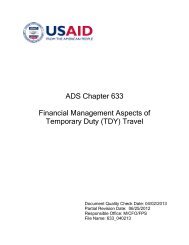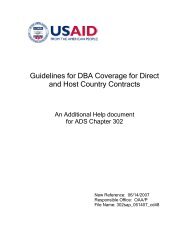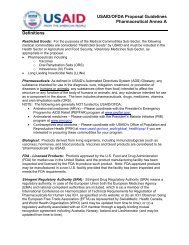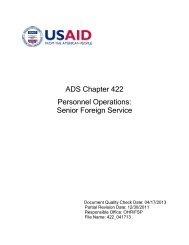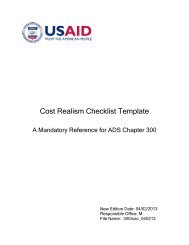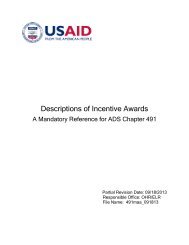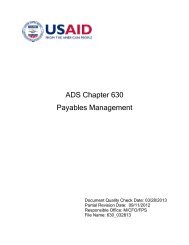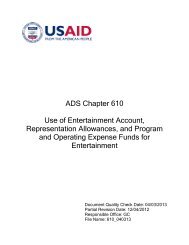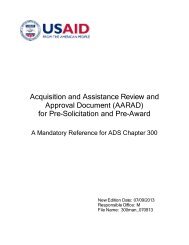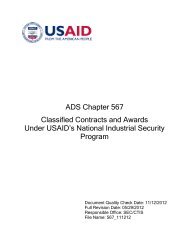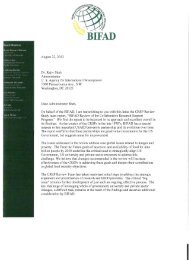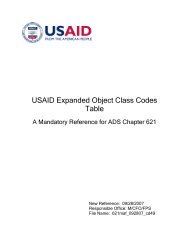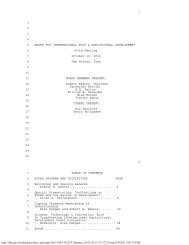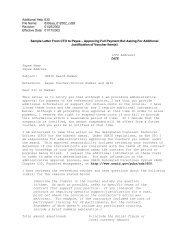USAID Policy Document - Resiliency FINAL 11-26-12.indd
USAID Policy Document - Resiliency FINAL 11-26-12.indd
USAID Policy Document - Resiliency FINAL 11-26-12.indd
- No tags were found...
You also want an ePaper? Increase the reach of your titles
YUMPU automatically turns print PDFs into web optimized ePapers that Google loves.
Letter from the AdministratorI am pleased to present <strong>USAID</strong>’s fi rst-ever policy and program guidance on building resilience to recurrent crisis. Drawn fromdecades of experience providing humanitarian relief and development assistance, this guidance aims to reduce chronic vulnerabilityand promote more inclusive growth in areas of recurrent crisis. Ultimately, we seek to save and improve lives and decreasethe need for repeated infusions of humanitarian assistance in these areas.The importance and urgency of this work has been made clear over the past year. In 20<strong>11</strong>, the worst drought in 60 yearsplunged 13.3 million people into crisis in the Horn of Africa. Only a few months later, another crisis emerged in the Sahel, wheremillions of people have suffered from the devastating impacts of drought, confl ict, and other pressures. The widespread needseen in these two regions refl ects similar diffi culties facing communities across the globe; in far too many places, families oftenrely on humanitarian assistance, year after year, just to survive.In response to these emergencies, the international community provides signifi cant levels of lifesaving relief, largely concentratedin just a few countries. Over the last decade, approximately US $90 billion was spent by international donors in just nine countries,accounting for almost 50 percent of all humanitarian assistance during this period. During the same time, three-quartersof <strong>USAID</strong> humanitarian assistance was spent in just 10 countries. Global trend lines and projections show clear and continuinggrowth in humanitarian need in certain regions, and climate change threatens to exacerbate both the frequency and severity ofextreme weather events and undercut important development gains.We can do better. That’s why <strong>USAID</strong> is working with committed and accountable governments and international partners tobuild resilient societies even while saving lives in times of crisis. While we cannot stop shocks from happening, we must increaseour focus on helping people and their societies withstand and recover from them. In the Horn of Africa, for example, we haveset a goal to directly benefi t 10 million people and reduce the region’s emergency caseload by 1 million people within 5 years.We expect to defi ne and realize similarly transformative impact in other areas where we apply this policy and program guidance.To do so, we are committed to identifying how to measure a broader range of results, with stronger monitoring and evaluationmechanisms for resilience.In order to reach these goals, we must strengthen the way we work as an agency. Too often, our humanitarian and developmentteams operate in separate geographic locations, on separate problems, with separate goals. To effectively build resilience we mustunite our approaches. While this is not an easy commitment, it is an important one, and we have begun to make progress. Overthe past year in the Horn of Africa and the Sahel, for example, we have created integrated agency units – called Joint PlanningCells – that are working to comprehensively address both humanitarian and development needs in close coordination withcountry governments and international partners. The effort of these teams demonstrates the powerful effect that we can havewhen we operate as a united Agency toward a singular goal. Leadership at all levels, in the fi eld and in Washington, is committedto facilitating and supporting the innovations necessary in our programming and operations to achieve our goals.We undertake these efforts because we believe they will strengthen our ability to save and improve lives. No one should have toface the crippling circumstances we have seen in the Horn of Africa and the Sahel over the past year. Through building resilience,we can help prevent that desperation, save lives, and create the conditions where families and communities can prosper.Dr. Rajiv J. Shah<strong>USAID</strong> AdministratorDecember 20123



